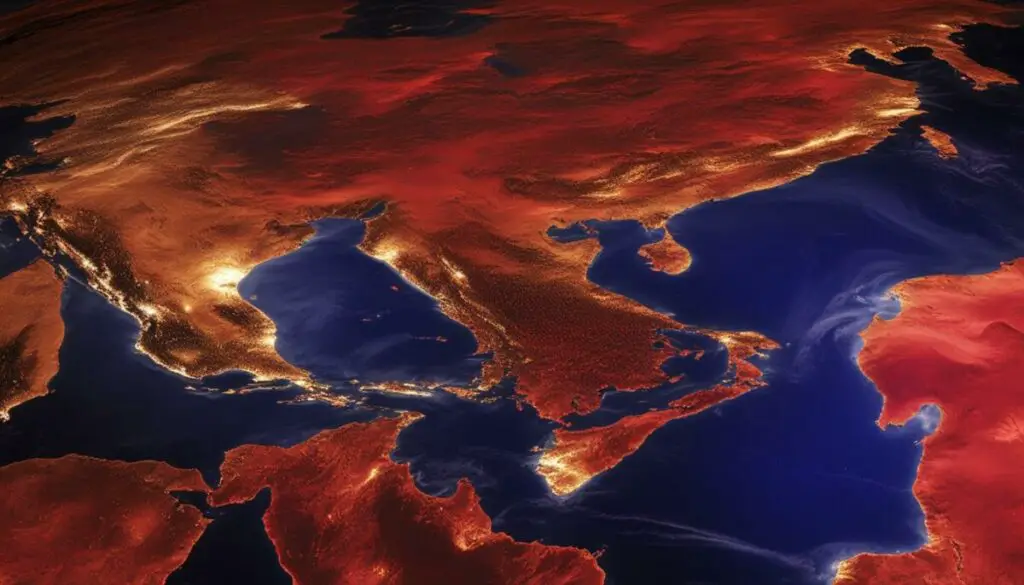Last Updated on 5 months by Francis
Welcome to a fascinating journey into the world of infrared radiation and its impact on our planet. In this section, we will explore what happens when infrared radiation reaches Earth and how it interacts with our planet’s atmosphere and climate system.
Infrared radiation is a type of electromagnetic radiation that is not visible to the human eye but can be felt as heat. It is emitted by all objects that have a temperature above absolute zero, including the Earth’s surface and atmosphere. As we will see, this radiation plays a crucial role in regulating Earth’s temperature and climate.
Contents
Key Takeaways:
- Infrared radiation is a type of electromagnetic radiation that is emitted by all objects with a temperature above absolute zero.
- It is not visible to the human eye but can be felt as heat.
- Infrared radiation plays a crucial role in regulating Earth’s temperature and climate.
Understanding Infrared Radiation

Before we discuss the effects of infrared radiation on Earth, let’s first understand what it is and why it’s important for our planet.
Infrared radiation refers to a type of electromagnetic radiation with wavelengths longer than those of visible light. This radiation is all around us, but it is invisible to the human eye. Infrared radiation is essential for the survival of life on Earth, as it helps to maintain our planet’s temperature.
Without infrared radiation, Earth would be too cold to support life. This is because infrared radiation is responsible for trapping heat in the atmosphere through a process called the greenhouse effect. The greenhouse effect is what keeps our planet warm enough for us to live on it.
The Importance of Infrared Radiation on Earth
Infrared radiation plays a crucial role in regulating Earth’s temperature and climate. Thanks to the greenhouse effect, infrared radiation helps to keep the planet warm enough for life to thrive. Additionally, infrared radiation is involved in the water cycle, which is essential for the survival of plant and animal life. Heat from the sun evaporates water from oceans, lakes, and rivers. This water vapor rises into the atmosphere, where it cools and condenses into clouds. These clouds release precipitation, which replenishes our planet’s water supply.
Infrared radiation also plays a role in photosynthesis, the process by which plants convert sunlight into energy. Infrared radiation is absorbed by chlorophyll in plant cells, which helps to power the photosynthesis process. Without infrared radiation, plants would not be able to produce the energy they need to survive, and the entire food chain would be disrupted.
Infrared Radiation Effects on Earth
While infrared radiation is essential for life on Earth, too much of it can have negative consequences. The greenhouse effect, which is caused by the trapping of infrared radiation in the atmosphere, can lead to global warming. As the planet warms, glaciers and ice caps melt, causing sea levels to rise and leading to more frequent and severe weather events.
Excessive exposure to infrared radiation can also be harmful to living organisms. Infrared radiation can cause skin burns and damage to the eyes. It can also cause dehydration, as it can increase the rate at which water is lost from the body.
It’s important to strike a balance with infrared radiation to ensure that it benefits life on Earth without causing harm. This is why monitoring and understanding infrared radiation is essential for protecting our planet and all its inhabitants.
The Basics of Infrared Radiation

Understanding how infrared radiation interacts with Earth’s atmosphere is crucial in comprehending the planet’s climate system. Infrared radiation is a form of electromagnetic radiation that has longer wavelengths than visible light. When the sun’s energy reaches the Earth’s surface, it warms the surface, and the Earth radiates heat back towards space as infrared radiation. However, not all of this energy can escape back into space; some of it is absorbed by greenhouse gases, including carbon dioxide, water vapor, methane, and nitrous oxide, in the Earth’s atmosphere.
The role of infrared radiation in the Earth’s climate system is to keep the planet’s temperature in balance. Without it, the Earth’s surface would be too cold to support life. Infrared radiation interacts with greenhouse gases in the atmosphere, causing them to vibrate and release heat. This heat warms the surrounding air and contributes to the greenhouse effect, which regulates the Earth’s temperature.
Infrared Radiation and the Atmosphere
When infrared radiation from the Earth’s surface passes through the atmosphere, it interacts with greenhouse gases, which absorb and re-emit the radiation. This process traps heat and contributes to the warming of the atmosphere. The amount of infrared radiation that is absorbed and re-emitted depends on the concentration of greenhouse gases in the atmosphere, which has been increasing in recent years due to human activities such as burning fossil fuels, deforestation, and industrial processes.
The absorption and re-emission of infrared radiation by greenhouse gases can also lead to the cooling of the upper atmosphere and the warming of the lower atmosphere. This can have an impact on weather patterns and the Earth’s climate system as a whole.
The Role of Infrared Radiation in Earth’s Energy Budget
Infrared radiation plays a crucial role in the Earth’s energy budget, which is the balance between the energy the Earth receives from the sun and the energy it radiates back into space. When the Earth absorbs solar radiation, it warms up and emits infrared radiation back into space. The amount of infrared radiation emitted depends on the temperature of the Earth’s surface. If the Earth’s temperature is too high, more infrared radiation is emitted to cool the surface and maintain a balance in the Earth’s energy budget.
However, when the concentration of greenhouse gases in the atmosphere increases, more infrared radiation is absorbed and re-emitted back to the surface, causing the Earth’s temperature to rise. This disrupts the Earth’s energy budget, leading to global warming and climate change.
Infrared Radiation and the Earth’s Surface

Now that we have a basic understanding of infrared radiation and its significance to the Earth’s climate system, let’s explore how it affects the planet’s surface. Infrared radiation is responsible for heating the Earth’s surface, and the amount of radiation that is absorbed by the surface depends on factors such as color, texture, and moisture content.
Dark-colored surfaces, such as asphalt or forests, absorb more infrared radiation than light-colored surfaces, like snow or sandy beaches. Surfaces with a rough texture, such as forests or rocky terrain, also absorb more infrared radiation than smooth surfaces like bodies of water. Additionally, moist surfaces absorb more infrared radiation than dry surfaces.
The effect of infrared radiation on the Earth’s surface can have significant impacts on land, water, and living organisms. For example, the absorption of infrared radiation by bodies of water leads to the heating of the water and affects ocean currents, which can have implications for climate patterns.
The absorption of infrared radiation by land surfaces can also impact the temperature and weather patterns of surrounding areas. For example, cities with many dark surfaces, such as buildings and roads, tend to be warmer than surrounding rural areas, which can lead to urban heat islands and affect local weather patterns.
Living organisms are also impacted by the absorption of infrared radiation. For example, the heating of bodies of water can affect aquatic ecosystems and lead to changes in the distribution of fish and other marine life.
Understanding the influence of infrared radiation on the Earth’s surface is crucial for predicting and mitigating the effects of climate change. By monitoring and measuring the amount of infrared radiation absorbed by different surfaces, scientists can better understand how the Earth’s temperature and weather patterns are affected.
The Greenhouse Effect

Before we look at the consequences of infrared radiation on Earth, it’s important to understand the significance of infrared radiation for our planet. Infrared radiation is a crucial component of the Earth’s energy balance, with the majority of it coming from the Sun. As sunlight enters the Earth’s atmosphere, it is absorbed by the planet’s surface and warms it up. The Earth then radiates this energy back into space as infrared radiation.
However, not all of this radiation escapes into space. Some of it is trapped in the Earth’s atmosphere by greenhouse gases, such as carbon dioxide and water vapor. This is known as the greenhouse effect, and it is a natural process that helps regulate the Earth’s temperature and keep it within a habitable range. Without the greenhouse effect, the Earth’s average temperature would be about -18°C, making it too cold to sustain life.
So, what happens when the concentration of greenhouse gases in the atmosphere increases? This is where infrared radiation begins to have consequences for the Earth. As the concentration of greenhouse gases increases, more radiation is trapped in the atmosphere, causing the Earth’s temperature to rise. This is known as global warming, and it is a significant concern for our planet. The increase in temperature can cause melting ice caps, rising sea levels, more frequent and intense weather events, and the loss of habitats for many plant and animal species.
Understanding the consequences of infrared radiation on Earth is crucial for developing strategies to mitigate its effects and address climate change. By reducing our carbon footprint and developing sustainable energy sources, we can work towards a future where our planet can thrive while still preserving its natural beauty and resources.
The Warming Effect

One of the most significant impacts of infrared radiation on Earth is its contribution to the warming of the planet’s temperature. Infrared radiation interacts with the Earth’s atmosphere, with the majority of it being absorbed and re-emitted as heat. This process is known as the greenhouse effect and is essential in regulating the Earth’s temperature.
The greenhouse effect works by trapping heat within the Earth’s atmosphere, which keeps the planet’s temperature stable and livable. However, human activities have increased the concentration of greenhouse gases in the atmosphere, primarily carbon dioxide, which traps more heat and contributes to the warming of the Earth’s temperature. This phenomenon is known as global warming, and its impacts are far-reaching and potentially catastrophic.
| Effects of Infrared Radiation on Earth’s Temperature | How Does Infrared Radiation Interact with Earth’s Atmosphere? |
|---|---|
| Infrared radiation contributes to the warming of the Earth’s temperature, primarily through the greenhouse effect. | Infrared radiation interacts with the Earth’s atmosphere by being absorbed and re-emitted as heat, which regulates the planet’s temperature. However, increased concentrations of greenhouse gases trap more heat and contribute to global warming. |
Scientists continue to monitor and study the impacts of infrared radiation on the Earth’s temperature, with the goal of understanding the complex interactions between the planet’s climate system and human activities. The consequences of global warming are far-reaching and could have severe implications for life on our planet, including rising sea levels, increased frequency of extreme weather events, and the loss of biodiversity.
To mitigate the effects of infrared radiation and address climate change, individuals, governments, and businesses must take action to reduce greenhouse gas emissions and transition to a more sustainable future. This includes investing in renewable energy sources, improving energy efficiency, and adopting sustainable practices in agriculture, transportation, and other industries.
Measuring Infrared Radiation

Measuring infrared radiation on Earth is crucial for understanding its impact on our planet’s climate system. Various methods and technologies are used to monitor and measure infrared radiation, including:
- Infrared radiometers: Devices that measure the intensity of infrared radiation emitted by the Earth’s surface and atmosphere.
- Spectroradiometers: Instruments that measure the intensity of infrared radiation at various wavelengths, providing a more detailed analysis of its characteristics.
- Weather balloons: Equipped with sensors that measure atmospheric temperature and humidity, which are used to calculate and analyze infrared radiation levels.
- Satellite-based sensors: These sensors measure infrared radiation emitted by the Earth’s surface and atmosphere from space, providing a comprehensive overview of infrared radiation levels and their distribution across the planet.
The data gathered from these measurements is used to understand how infrared radiation interacts with Earth’s atmosphere, affects weather patterns, and contributes to climate change. Monitoring infrared radiation levels is essential for identifying trends and developing strategies to mitigate its effects on our planet.
“Understanding the role of infrared radiation in our climate system allows us to work towards mitigating its effects and building a sustainable future for generations to come.”
Infrared Radiation and Weather Patterns

Have you ever wondered how infrared radiation affects our weather patterns? Let’s explore how this phenomenon influences the formation of clouds and precipitation.
Infrared radiation plays a crucial role in the water cycle, which is essential for all life on Earth. It is responsible for heating the surface of the Earth, which causes water to evaporate and rise into the atmosphere.
As moist air rises, it cools and condenses into clouds. Infrared radiation is also responsible for the energy that drives thunderstorms and other intense weather events.
Additionally, infrared radiation is absorbed by different molecules in the atmosphere, which can affect the temperature and pressure of the surrounding air. This, in turn, can influence the movement of air masses, leading to changes in weather patterns.
Overall, infrared radiation is a key factor in weather patterns and is essential for the water cycle and the overall health of our planet.
Table: The Relationship Between Infrared Radiation and Weather Patterns
| Effects of Infrared Radiation on Weather Patterns | Examples |
|---|---|
| Heating the Earth’s surface, leading to evaporation and the water cycle | Formation of clouds and precipitation |
| Absorbed by different molecules in the atmosphere, affecting temperature and pressure | Influence on the movement of air masses, leading to changes in weather patterns |
“Infrared radiation is a key factor in weather patterns and is essential for the water cycle and the overall health of our planet.”
As we can see, infrared radiation has a significant impact on our weather patterns, as well as the overall health of our planet. With this knowledge, we can better understand the importance of this phenomenon and its role in our ecosystem.
Infrared Radiation and Climate Change
The role of infrared radiation in climate change is a subject of significant concern. Greenhouse gases, including carbon dioxide, absorb and emit infrared radiation, trapping it in the Earth’s atmosphere and leading to a rise in temperature. This effect, known as the greenhouse effect, is a key contributor to climate change and its associated impacts, including sea-level rise, more frequent and intense heatwaves and droughts, and increased frequency of extreme weather events.
According to NASA, the Earth’s temperature has increased by approximately 1.8°F (1.0°C) since the late 19th century, with much of the warming occurring in the past few decades. This warming can be attributed in part to human activities, such as burning fossil fuels and deforestation, which release large amounts of greenhouse gases into the atmosphere and contribute to the enhanced greenhouse effect.
The Paris Agreement
The international community has recognized the need to address climate change and reduce the emissions of greenhouse gases. The Paris Agreement, adopted in 2015, aims to limit global warming to well below 2°C above pre-industrial levels and to pursue efforts to limit the temperature increase to 1.5°C above pre-industrial levels.
Under the agreement, countries have pledged to take action to reduce their greenhouse gas emissions and to regularly report on their progress. The agreement also includes provisions for financial and technological support for developing countries to help them mitigate and adapt to the impacts of climate change.
The Role of Infrared Radiation Monitoring
Monitoring and measuring infrared radiation is essential for understanding and addressing climate change. Remote sensing technologies, such as satellites and ground-based instruments, can be used to monitor changes in the Earth’s temperature, atmospheric composition, and other parameters that are affected by the greenhouse effect.
The information gathered through these monitoring efforts can be used to improve climate models and to develop more effective strategies for mitigating the impacts of climate change. For example, monitoring infrared radiation can help identify the sources and extent of greenhouse gas emissions, allowing policymakers and stakeholders to target their efforts to reduce these emissions.
“Climate change is real, it is happening right now. It is the most urgent threat facing our entire species, and we need to work collectively together and stop procrastinating.” – Leonardo DiCaprio
Mitigating the Effects of Infrared Radiation
As the impact of infrared radiation on Earth becomes increasingly apparent, many organizations and individuals are working towards mitigating its effects and addressing climate change. There are various strategies and initiatives aimed at reducing the amount of infrared radiation that reaches Earth, including:
- Reducing greenhouse gas emissions: The primary driver of the greenhouse effect, which traps heat in the Earth’s atmosphere, is the high concentration of carbon dioxide and other greenhouse gases. By reducing emissions from burning fossil fuels and other human activities, we can help mitigate the effects of infrared radiation.
- Increasing energy efficiency: By using energy more efficiently, we can reduce the amount of fossil fuels needed to power our homes, businesses, and transportation systems, thus reducing the amount of infrared radiation emitted into the atmosphere.
- Investing in renewable energy: Renewable energy sources like solar, wind, and hydropower generate electricity with little to no emissions, reducing the amount of infrared radiation reaching Earth.
- Planting trees and preserving forests: Trees and other vegetation absorb carbon dioxide and other greenhouse gases, reducing the amount of infrared radiation in the atmosphere.
By implementing these and other strategies, we can work to mitigate the effects of infrared radiation and address the broader issue of climate change. It is important to note that individual actions can make a difference, whether it’s driving less, using energy-efficient appliances, or supporting renewable energy policies.
Future Implications and Research
As our planet continues to experience the effects of infrared radiation, it’s crucial that we focus on ongoing research initiatives and future implications to better understand this phenomenon. One of the most pressing concerns is the impact of infrared radiation on climate change, which has far-reaching implications for the future of our planet.
Scientists are currently exploring various strategies and technologies to mitigate the effects of infrared radiation on Earth, including carbon capture, solar geoengineering, and sustainable energy solutions. These efforts are essential in addressing climate change and building a sustainable future for our planet.
Furthermore, ongoing research on infrared radiation is expanding our understanding of its impact on weather patterns, atmospheric dynamics, and oceanic processes. This research is critical in developing accurate climate models and predicting future climate trends.
Overall, the future implications of infrared radiation on Earth are significant, and continued research efforts are necessary to address this issue and safeguard the health and well-being of our planet and its inhabitants.
Conclusion
We have explored the fascinating world of infrared radiation reaching Earth and its significant impact on our planet. It is clear that infrared radiation plays a crucial role in regulating Earth’s temperature, influencing weather patterns, and shaping the planet’s climate system.
As we continue to study the effects of infrared radiation, it is essential that we work towards mitigating its impact and building a sustainable future for generations to come. Whether it’s reducing greenhouse gas emissions or developing new technologies to measure and monitor infrared radiation, we must take action to protect our planet and the delicate balance of its ecosystem.
By understanding the role of infrared radiation in our climate system and working towards solutions to mitigate its effects, we can create a brighter and healthier future for all living beings on Earth. Let’s continue to unlock the mysteries of what happens when infrared radiation reaches Earth and use our knowledge to make a positive impact on the world.
FAQ
What is infrared radiation?
Infrared radiation is a type of electromagnetic radiation that has longer wavelengths and lower frequencies than visible light. It is commonly referred to as heat radiation and is emitted by warm objects.
How does infrared radiation reach Earth?
Infrared radiation reaches Earth through various sources, including the Sun, the Earth’s own heat, and human-made sources such as industrial processes and electronic devices.
What are the effects of infrared radiation on Earth?
Infrared radiation plays a crucial role in the Earth’s climate system, contributing to the warming of the planet’s temperature. It also affects weather patterns, influences the greenhouse effect, and has implications for climate change.
How does infrared radiation interact with the Earth’s atmosphere?
Infrared radiation interacts with Earth’s atmosphere by being absorbed and re-emitted by greenhouse gases such as carbon dioxide and water vapor. This interaction traps heat in the atmosphere, leading to an increase in surface temperature.
Is infrared radiation harmful to living organisms?
Infrared radiation itself is not harmful to living organisms in moderate amounts. However, excessive exposure to heat radiation can cause burns and other thermal injuries.
How is infrared radiation measured?
Infrared radiation is measured using specialized instruments called radiometers or infrared thermometers. These devices detect and quantify the amount of infrared radiation emitted or reflected by objects.
Can we mitigate the effects of infrared radiation?
Yes, various strategies and initiatives are aimed at mitigating the effects of infrared radiation on Earth, such as reducing greenhouse gas emissions, promoting renewable energy sources, and implementing energy-efficient practices.
What ongoing research efforts are there on infrared radiation?
Ongoing research focuses on further understanding the impacts of infrared radiation on Earth’s climate system, developing advanced measurement techniques, and exploring innovative solutions to address climate change and global warming.








